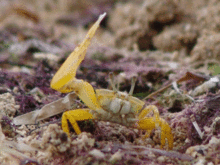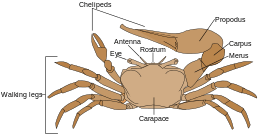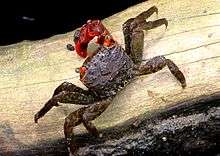Fiddler crab
| Uca | |
|---|---|
 | |
| Uca pugnax | |
| Scientific classification | |
| Kingdom: | Animalia |
| Phylum: | Arthropoda |
| Subphylum: | Crustacea |
| Class: | Malacostraca |
| Order: | Decapoda |
| Infraorder: | Brachyura |
| Family: | Ocypodidae |
| Subfamily: | Ucinae Dana, 1851 |
| Genus: | Uca Leach, 1814 |
| Species | |
|
ca. 100; see text | |
A fiddler crab, sometimes known as a calling crab, may be any of approximately 100 species of semi-terrestrial marine crabs which make up the genus Uca.[1] As members of the family Ocypodidae, fiddler crabs are most closely related to the ghost crabs of the genus Ocypode. This entire group is composed of small crabs – the largest being slightly over two inches across. Fiddler crabs are found along sea beaches and brackish inter-tidal mud flats, lagoons and swamps. Fiddler crabs are most well known for their sexually dimorphic claws; the males’ major claw is much larger than the minor claw while the females’ claws are both the same size.[2]
Like all crabs, fiddler crabs shed their shells as they grow. If they have lost legs or claws during their present growth cycle, a new one will be present when they molt. If the large fiddle claw is lost, males will develop one on the opposite side after their next molt. Newly molted crabs are very vulnerable because of their soft shells. They are reclusive and hide until the new shell hardens.
Fiddler crabs exhibit a constant circadian rhythm in a controlled laboratory setting that mimics the ebb and flow of the tides. The crabs turn dark in the day and light in the dark.[3]
Ecology
Found in mangroves, in salt marshes, and on sandy or muddy beaches of West Africa, the Western Atlantic, the Eastern Pacific and the Indo-Pacific, fiddler crabs are easily recognized by their distinctively asymmetric claws.

Fiddler crabs communicate by a sequence of waves and gestures;[4] males have an oversized claw or chela; used in clashes of ritualised combat of courtship over a female and signal their intentions between conspecifics. The movement of the smaller claw from ground to mouth during feeding explains the crabs' common name; it looks as if the animal were playing the larger claw like a fiddle.
The crab's smaller claw picks up a chunk of sediment from the ground and brings it to the mouth, where its contents are sifted through (making the crab a detritivore). After anything edible is salvaged, be it algae, microbes, fungus, or other decaying detritus, the sediment is replaced in the form of a little ball. The presence of these sediment balls near the entrance to a burrow is a good indication of its occupation. Some experts believe that the feeding habits of fiddler crabs play a vital role in the preservation of wetland environments; by sifting through the sands, they aerate the substrate and prevent anaerobic conditions.
Life cycle

Fiddler crabs live rather brief lives of no more than two years (up to three years in captivity). Male fiddler crabs use the major claw to perform a waving display as a form of female courtship.[5] Females choose their mate based on claw size and also quality of the waving display.[6] In many fiddler crab species, the female occupies the burrow of their mate while she lays her clutch of eggs. Research shows that the male major claw size is also correlated with burrow width; the width of the burrow influences incubation temperature.[7] Therefore, the female will choose a male mate whose claw size indicates the best burrow environment for her clutch of eggs. The waving display is also thought to indicate to females the overall healthiness of the male; a more vigorous display is more difficult to do and thus requires the male to be in prime health condition, which suggests that the male will help produce viable offspring.[8]
Male versus male competition also occurs as fighting with the major claws.[9] If a male loses his larger claw, the smaller one will begin to grow larger and the lost claw will regenerate into a new (small) claw. For at least some species of fiddler crabs, however, the small claw remains small, while the larger claw regenerates over a period of several molts, being about half its former size after the first molt. The female fiddler carries her eggs in a mass on the underside of her body. She remains in her burrow during a two-week gestation period, after which she ventures out to release her eggs into the receding tide. The larvae remain planktonic for a further two weeks.
Fiddler crabs such as Uca mjoebergi have been shown to bluff about their fighting ability. Upon regrowing a lost claw, a crab will occasionally regrow a weaker claw that nevertheless intimidates crabs with smaller but stronger claws.[10][11] This is an example of dishonest signalling.
The dual functionality of the major claw of fiddler crabs has presented an evolutionary conundrum in that the claw mechanics best suited for fighting do not match up with the mechanics best suited for a waving display.[12]
Subgenera and species
The internal classification of the genus Uca is unstable, but it contains around 100 species arranged among 9 subgenera:[13]
|
|
|
|
gallery


Captivity
Fiddler crabs are occasionally kept as pets.[15] The fiddler crabs sold in pet stores generally come from brackish water lagoons. Because they live in lower salinity water, pet stores may call them fresh-water crabs, but they cannot survive indefinitely in fresh water.[15]
See also
References
- ↑ M. S. Rosenberg (2001). "The systematics and taxonomy of fiddler crabs: a phylogeny of the genus Uca" (PDF). Journal of Crustacean Biology. 21 (3): 839–869. doi:10.1651/0278-0372(2001)021[0839:TSATOF]2.0.CO;2. ISSN 0278-0372.
- ↑ Levinton, J. S., Judge, M. L., and Kurdziel, J. P., 1995, Functional differences between the major and minor claws of fiddler crabs (Uca, family Ocypodidae, order Decapoda, Subphylum Crustacea): A result of selection or developmental constraint?: Journal of Experimental Marine Biology and Ecology, v. 193, p. 147-160.
- ↑ Smith, Thomas; Smith, Robert (2012). Elements of Ecology (8 ed.). San Francisco: Pearson Benjamin Cummings. p. 144. ISBN 978-0-321-73607-9.
- ↑ M. J. How; J. M. Hemmi; J. Zeil; R. Peters (2008). "Claw waving display changes with receiver distance in fiddler crabs, Uca perplexa" (PDF). Animal Behaviour. 75 (3): 1015–1022. doi:10.1016/j.anbehav.2007.09.004.
- ↑ Pope, D. S., 2000, Testing function of fiddler crab claw waving by manipulating social context: Behavioral Ecology and Sociobiology, v. 47, p. 432-437.
- ↑ Perez, D. M., Rosenberg, M. S., and Pie, M. R., 2012, The evolution of waving displays in fiddler crabs (Uca spp., Crustacea: Ocypodidae): Biological Journal of the Linnean Society, v. 106, p. 307-315.
- ↑ Reaney, L. T., and Backwell, P. R. Y., 2007, Temporal constraints and female preference for burrow width in the fiddler crab, Uca mjoebergi: Behavioral Ecology and Sociobiology, v. 61, p. 1515-1521.
- ↑ Matsumasa, M., Murai, M., and Christy, J. H., 2013, A low-cost sexual ornament reliably signals male condition in the fiddler crab Uca beebei: Animal Behaviour, v. 85, p. 1335-1341.
- ↑ Callander, S., Kahn, A. T., Maricic, T., Jennions, M. D., and Backwell, P. R. Y., 2013, Weapons or mating signals? Claw shape and mate choice in a fiddler crab: Behavioral Ecology and Sociobiology, v. 67, p. 1163-1167.
- ↑ British Ecological Society (November 13, 2008). "Fiddler crabs reveal honesty is not always the best policy". University of New South Wales. Retrieved November 19, 2008.
- ↑ Simon P. Lailvaux; Leeann T. Reaney; Patricia R. Y. Backwell (November 11, 2008). "Regenerated claws dishonestly signal performance and fighting ability in the fiddler crab Uca mjoebergi". Functional Ecology. 23 (2): 359. doi:10.1111/j.1365-2435.2008.01501.x. Retrieved November 18, 2008.
- ↑ Swanson, B. O., George, M. N., Anderson, S. P., and Christy, J. H., 2013, Evolutionary variation in the mechanics of fiddler crab claws: Bmc Evolutionary Biology, v. 13.
- ↑ Peter K. L. Ng; Danièle Guinot; Peter J. F. Davie (2008). "Systema Brachyurorum: Part I. An annotated checklist of extant Brachyuran crabs of the world" (PDF). Raffles Bulletin of Zoology. 17: 1–286.
- ↑ Hsi-Te Shih; Tohru Naruse; Peter K. L. Ng (2010). "Uca jocelynae sp. nov., a new species of fiddler crab (Crustacea: Brachyura: Ocypodidae) from the Western Pacific" (PDF). Zootaxa. 2337: 47–62.
- 1 2 Lianne McLeod. "How to Set Up a Tank for Fiddler Crabs". About.com. Retrieved January 13, 2010.
External links
| Wikimedia Commons has media related to Uca. |
- Movie of two fiddler crabs (Uca lactea lactea) waving the enlarged claw - University of Kyoto
- Info on systematics, phylogeny and morphology of fiddlers - Fiddlercrab.info
- The colorful fiddler crabs in the mangrove forest of Borneo - mysabah.com
_male.jpg)
